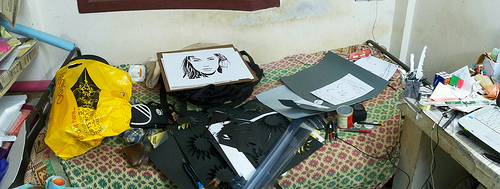Brazilian painting

Photograph by Bharath Kishoreon Flickr.
Victor Meirelles, Pedro Américo, and Almeida Junior were the Landscape art leaders of such academic art, but this period also received important contributions from foreigners like Georg Grimm, Augusto Müller, and Nicola Antonio Facchinetti. In 1889 the monarchy was abolished, and the republican government renamed the Imperial Academy the National School of the Fine Arts, which would be short-lived, absorbed in 1931 by the Federal University of Rio de Janeiro. 1830. Agostinho da Motta: Still-life, 1860 Victor Meirelles: Moema, 1866. Pedro Américo: Battle of Avaí, 1872-77. Johann Georg Grimm: Icaraí, 1884 Almeida Junior: Model s rest, 1882. Belmiro de Almeida: Effects of sunlight, 1893 Manuel Lopes Rodrigues: Alegory of the Republic, 1896. Jerônimo José Telles Júnior: Wind storm, 1902 Antônio Parreiras: Sorrowful, 1909 Ismael Nery: Nude woman crouching. Ado Malagoli: The black cat, ca.
However, Baroque painting still survived in many places until the end of the 19th century. Meanwhile, Modernism was already being cultivated in São Paulo and by some academic painters, and the new movement superseded Academicism.
Under government patronage he dominated Brazilian painting in the mid-20th century until Abstractionism showed up in the 1950s. The period between 1950 and 1970 witnessed the emergence of many new styles. Then Brazilian painting showed a new strength, spread across the whole country, and started being appreciated in international forums. Ricardo do Pilar: The man of sorrows, XVIIth century João Nepomuceno Correia e Castro: The Immaculate Conception, XVIIIyh century Manuel de Jesus Pinto: St.
Cândido Portinari is the best example of this last tendency. In 1922 the event called Week of Modern Art broke definitely with academic tradition and started a nationalist trend which was, however, influenced by Primitivism and by European Expressionism, Surrealism and Cubism.
Major painters in this period were Ricardo do Pilar, José Joaquim da Rocha, José Teófilo de Jesus, Joaquim José da Natividade, José Eloy, Manuel de Jesus Pinto, João de Deus Sepúlveda, Manuel da Cunha, but chief among them was Manuel da Costa Ataíde, working towards the end of the 18th century, head of the first original school of painting in the country, with a delicate and somewhat personal interpretation of Rococo style in which he first depicted angels and saints with mulato features. A sudden break with the Baroque tradition was imposed on the art of the nation by the arrival of the Portuguese court in 1808, fleeing the French invasion of Portugal. Brazilian painting emerged in the late 16th century, influenced by the Baroque style imported from Portugal.
1950. Geraldo Trindade Leal: Ginete, 1951. Jader Siqueira: Triptych, 1977 Carlos Carrion de Britto Velho: Painting #2, 1977. Milton Kurtz: Quasi contacto, 1989. . Peter receiving the keys of the Church, ca.
In 1816, the king, John VI, supported the project of creating a national Academy at the suggestion of some French artists led by Joachim Lebreton, a group later known as the French Artistic Mission. After a period of relative decline in the conceptualist 1970s, national art revived in the 1980s under the influence of the world s renewed interest in traditional painting.
1804-1815. Manuel da Costa Ataíde: Our Lady surrounded by musician angels, early XIXth century. Simplício de Sá: Portrait of emperor Peter I, ca. Through the following 70 years, the Royal School of Sciences, Arts and Crafts, later renamed the Imperial Academy of Fine Arts, would dictate the standards in art, a mixed trend of Neoclassicism, Romanticism, and Realism with nationalist inclinations which would be the basis for the production of a large amount of canvases depicting the nation s history, battle scenes, landscapes, portraits, genre painting, and still lifes, and featuring national characters like black people and Indians.
Action painting, Lyrical Abstraction, Neoconcretism, Neoexpressionism, Pop art, Neorealism—all contributed to some extent to the creation of huge diversity in Brazilian painting and to the updating of Brazilian art. Anita Malfatti, Ismael Nery, Lasar Segall, Emiliano di Cavalcanti, Vicente do Rego Monteiro, and Tarsila do Amaral wrought major changes in painting, while groups like Santa Helena and Núcleo Bernardelli evolved toward a moderate interpretation of Modernism, with important artists such as Aldo Bonadei and José Pancetti.
